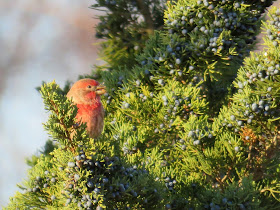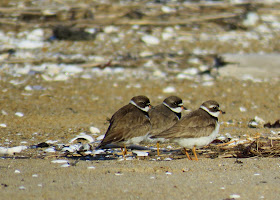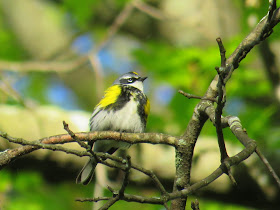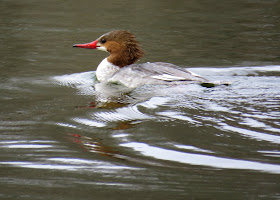 |
A Great Horned Owl. Top of the food chain. Good for
marketing blog posts. |
In February 2016, our book club read
The Big Year. It's the story of three men who, in 1998, competed to establish a North American birding record. One succeeded, counting 748 species.*
Until that book settled in my Kindle, I had no idea that there was a thing called "birding," or that there was an entire world of hikers, world travelers, citizen scientists, ornithologists, and conservationists who spent much of their waking time watching and studying birds.
For me, this activity was an epiphany--who else knew? It turns out,
50 million Americans plan an outing to observe birds every year.

But if birding was epiphany, it would also turn out to be escape. In early 2016, I needed to get away from my screens in the worst way, far from our new administration and the damage it was inflicting on the American democratic experiment. My Facebook feed was turning toxic, and Twitter went from being noise to a black hole of contempt sucking energy and goodwill out of our nation.
In the process, I traded tweets for tweets, heading into the woods with my
Sibley bird book, camera,
ebird app, and binoculars, sometimes with an experienced guide from
Mass Audubon. It was like stepping inside a huge video game (with fresh air) where I needed to focus, observe, and, in the words of Monty Python, prepare for something completely different.
Flash ahead to December 2019. I now have 286 species on my life list. (There are people who count nearly that many different birds every few months, but I persist.) More to the point, I now know what a life list
is. The
Ipswich River Wildlife Sanctuary and
Plum Island have become second homes and places of refuge. And every so often, by being patient and lucky, I'll take a picture I like of a bird I like.
Here, then, in an ongoing trade of tweets for tweets, are my favorites photos from 2019:
 |
These two Pileated Woodpeckers met me on our driveway as I returned home from a run. They were nice enough to
stick around while I dashed inside to get my camera. |
 |
| I call this one "The Chase." (Only professional photographers get to name their pictures, but I'll cheat a little, just this time.) Canada Geese are so plentiful and can be such a nuisance that they don't get much respect, but they are striking birds. |
 |
| I got up early one morning and drove to a park in the center of Portland, Maine, to take this picture. It's a Great Black Hawk, native to Central and South America. It would be uncommon to see this handsome hawk in Texas; having one make its way to Maine was a shock. Unfortunately, this poor lost soul, whose feet are not adapted to cold winters, caught severe frostbite and had to be euthanized. |
 |
| This battle went on for quite some time, but there was little doubt the Great Blue Heron would win. |
 |
| Ducks, Herons, Egrets. It was a little far for my lens, but it helps explain why I bird on Plum Island. |
 |
| A massing of Tree Swallows. Also Plum Island. Spectacular. |
 |
| This Bluebird was king of the hill at the Ipswich River Audubon, at least for a moment. |
 |
| A Northern Harrier out for breakfast, hanging nearly motionless in the wind. |
 |
| A common visitor to the suet outside my window, this fat Carolina Wren looked ready for winter. |
 |
| Two European Starlings match their surroundings on a barn in Gettysburg. Introduced to Central Park in the 1890s by Shakespeare fans who wanted North America to be home to all of the birds mentioned in the Bard's works, Starlings now number 200 million. I like them for their spectacular colors and impressive flocks. However, Starlings are destructive to crops and compete aggressively and successfully with Bluebirds and other native cavity-nesters. |
 |
| This American Robin was stuffing itself near the beaver dam that has transformed the woods around our property. Beavers to me are like classical music and Elvis Presley; I appreciate them--just don't ask me to love them. |
 |
| The Black-capped Chickadee is the Massachusetts state bird. They are tolerant of humans and almost always first to find seed in the feeder. As the summer ends, their hippocampus expands, enhancing their spatial memory. Then they go about hiding seed behind bark all over the forest--and will remember where it is throughout the long winter months. No kidding. Not to be confused with the Carolina Chickadee (which I do--confuse them, that is), the two species overlap in a 30-mile band not too far south of the state, a band that is moving north rapidly thanks to climate change. The bad news is, the Carolina will eventually push Massachusett's state bird out of the state. The good news, I won't be able to tell the difference. |
 |
| This is what I mean about Black-capped Chickadee being tolerant--and first to a feeder. This was me snowshoeing last weekend, helping feed the hungry. Some people frown on feeding wild birds in the wild. But imagine waking up and having all of your food covered in snow or frozen to the sides of the refrigerator. A handout here and there can't hurt. |
 |
This Bluebird was sitting on a trailer in the side yard of the Ipswich Audubon, the very spot (two pictures down) where
I would photograph a Red-tailed Hawk the same week. If you want oohs and ahhs, show people pictures of Bluebirds. It's
why Starlings get a bad rep; they sometimes chase these little guys out of their cavity nests. |
 |
| This tough guy, a Northern Saw-whet Owl, is part of a wildlife demonstration, hurt and unable to function on its own in the wild. I kept the picture because, while I'd prefer to photograph birds in the wild--and there are tons of Saw-Whet Owl around--they are nearly impossible to see. Nocturnal, they nest in dense conifers and tree cavities. About the size of a robin, they seem cute to us but are deadly predators who love mice and small mammals. Death is swift, silent, and completely unexpected with the Saw-whet. Never mess with owls in general, even the small and cute ones. |
 |
Here's the Red-tailed Hawk I mentioned, a resident of the Ipswich Audubon. Red-tails are all over Massachusetts, having
adapted especially well to highway life where small rodents scurry along the apron near the interstates. |
 |
| This Northern Flicker (a male, which you can tell by his mustache), visits the suet I place outside my office window. Even though I am behind glass and about ten feet away, I can barely blink without causing him to take flight. It took about three minutes to lift my camera to my face for this shot, moving only when his beak was buried in the suet cake. If you were this colorful and meaty, you'd be careful, too. |
 |
This is the Eskimo Owl, rarely spotted in New England and . . . ok, ok. This is a shameless plug for Innovation on Tap, which you can find as hardcover, audio, and Kindle version on Amazon. (And please leave a review!)
Shameless plug ended. |
 |
| This House Finch is dining in a tree on Plum Island. If I had to pick a Christmas card picture, this might be it. |
 |
| This is the fattest Cedar Waxwing I have ever seen. Wayne Petersen writes in his "Field Guide to Birds of Massachusetts" that Waxwings love berries and, if they partake of overripe berries, they can become intoxicated--flopping on the ground and becoming easy prey. This one stayed upright, at least for his portrait. |
 |
| This was my first-ever Red-headed Woodpecker, spotted one afternoon on the battlefield at Gettysburg. I am told that they are particular not just to a territory, but to a single tree. I am hoping to go back this year and find him again. (For a small donation to the Gettysburg Foundation, I'll tell you where. :) |
 |
| Also found on the Gettysburg battlefield, this Eastern Phoebe let me swing around and get the red barn lined up. Since their call is "PHEE-BEE," this species is one of the few birds I can identify by ear. One of the hardest lessons for new birders is to discover that birding by sight-only is like trying to play a piano concerto without having learned the left hand. |
 |
| This female Red-winged Blackbird (at least, that's my best guess) is prettier than her more boisterous mate. |
 |
| I found this Scarlet Tanager by ear because I remembered it sounds like an American Robin with a sore throat. (I have now nearly exhausted my knowledge of bird sounds.) |
 |
| In August, I visited the Hartwick Pine State Forest in Michigan, hoping to spot a Kirtland Warbler. The entrance guide said I had almost no chance--too late in the season--and she was correct. Alas. But I was able to hike through some of the last remaining old-growth forest in Michigan, a real treat. And I also found this Rose-breasted Grosbeak by ear because I remembered it sounds like an American Robin that has taken singing lessons. And now I HAVE exhausted all of my knowledge of bird calls. |
 |
| I am not good with shorebirds, but I do believe these are Semipalmated Plovers, staying warm on the beach at Plum Island. Piping Plovers, a threatened species, cause the wildlife folk to shut down about six miles of this beach from April until the young Plovers fledge in August. There are also Wilson's Plovers and Snowy Plovers and Black-bellied Plovers and American Golden Plovers, and then there are Kildeer and Sanderlings. And they're all hopping and bopping around Plum Island, confusing fledging birders. |
 |
| The first spring that I birded, I was with a group on Plum Island whose members were very excited about something called "Warblers." I did not know such a thing existed. Then, when we started seeing them--and "seeing" is a relative term for a Warbler--I found there were Blackburnian and Pine, Palm and Cerulean, Tennessee and Nashville and Cape May and Connecticut, Yellow and Common Yellowthroat, Magnolia and Chestnut-sided, American Redstart; it was like finding out in French class that, right after the pain of mastering "Je suis, Tu es," you had to learn passe compose, passe anterieur, imparfait futur simple and plus que parfait. Anyway, here's a Blackburnian Warbler. |
 |
| And here's a Palm Warbler. |
 |
| And here's a Black-and-White Warbler, mercifully named in a way that I can remember. |
 |
Near as I can tell, this Great Blue Heron has caught a small Swordfish, though
someone who knows fish might have a better ID. |
 |
| This Swainson's Thrush is resting on a gravestone in Lowell Cemetery, a historic burial ground and wonderful birding area not far from my home. Harry Livermore Abbott is buried there; Abbott was one of three unwounded officers of the 20th Massachusetts that helped beat back Pickett's Charge at Gettysburg. The late Senator Paul Tsongas is buried a few yards from our Swainson's. |
 |
| Back to the Warblers: this is a Magnolia. |
 |
| This is a Bay-breasted Wabler, also photographed at the Lowell Cemetery. |
 |
| Here's one of our backyard female Ruby-throated Hummingbirds, the only kind of Hummingbirds we normally see in New England. They are God's greatest fliers and put on a show when defending their territory--which is pretty much 24 x 7. They are not afraid to buzz me if I decide to eat lunch on the patio and they decide I have ventured too close to their nectar. |
 |
| Here's a Plum Island Barred Owl, still bloody from brunch. Ours was a chance meeting: I was walking along, looking up; he was down on the ground eating. I got within a few feet of him before we saw one another. He flew up to a nearby tree, willingly posed, and then I departed so he could finish eating. |
 |
| This was another chance meeting, me looking up and this Pileated Woodpecker working for breakfast down low on a fallen log. He took off, hooting and hollering but stopped on this tree so that I could get a sunrise shot. |
 |
| The Common Merganser is a species of duck that I envision Dr. Suess saw one day before he started drawing. |
 |
| This Northern Cardinal was molting, a terrible thing birds do to new birders to make them even harder to identify. |
 |
| These Mallards in-flight show their beautiful colors. |
 |
| I spotted his Egret outside our hotel in Burlingame, CA, one morning. The marsh and shore here is full of birds despite constant racket from SFO. |
 |
| Nearby, a Western Grebe. |
 |
| Also nearby, this Marbled Godwit was wading for breakfast. If I ever write a novel, the heroine will surely be Mabel Godwit. |
 |
| The area outside this particular hotel in Burlingame was filled with surprises. Sitting quietly near a bridge, I found several Black-capped Night Heron. |
 |
| This Great Horned Owl and chick (including a mate and two chicks you cannot see) had taken over the nest of a Great Blue Heron in a rookery not far from our home. A good rule of thumb: Don't. Mess. With. A. Great. Horned. Owl. They don't build their own nests and are just as likely to steal one from a Red-tailed Hawk. |
 |
| This angry bird is a Purple Martin, finding home sweet home in manmade cavity nests on Plum Island. |
 |
| The Snowy Owl is the Beyonce of the bird world. Once December rolls around, if you see cars and trucks gathered anywhere on Plum Island or Salisbury Beach, you can bet why they're there. |
 |
| The gentleman with the truck was nice enough to let me climb aboard and plant my camera. Birders are some of the nicest people in the world. |
 |
| In February, I had the opportunity to do some birding in southwestern Arizona--Sweetwater Wetlands, Santa Cruz Flats, Whitewater Draw Wildlife Refuge, Madera Canyon, and Coronado National Forest, to name a few locations our Audubon gang visited. This pink-legged beauty is a Black-necked Stilt. |
 |
| The Curved-Bill Thrasher is common in the canyons and brushlands of Arizona but will also head for the Great Plains, and a few end up in the panhandle of Florida. |
 |
| This is Whitewater Draw, a protected area that can gather as many as 20,000 Sandhill Cranes. |
 |
| Looking like the molting Northern Cardinal shown earlier, this Pyrrhuloxia likes thorny bush, mesquite thickets, and ranchlands, but can also be found hanging out on oil rigs in the Gulf of Mexico. |
 |
| Possibly another source for Dr. Suess, this is a Gambel's Quail. |
 |
| Yellow-bellied Sapsuckers are fairly common but not always easy to find. This one sat up nicely but very briefly for his portrait. |
 |
| This is an Acorn Woodpecker, which many bird guides say is the inspiration for Woody Woodpecker. Since the Pileated Woodpecker (see above) seems like a more obvious candidate, our Audubon troupe engaged in a lengthy google search and discussion. The guides are correct; Woody is modeled on the Acorn. |
 |
| While not a great picture, this might have been the only Elegant Trogon in the United States on the day we spotted it. It was late in the day and we had given up hope when we finally found our bird. My experience with birding is, like fishing, that some of the best stuff happens at the end of the day when you are about to reel up your line. |
 |
| This is the beautiful American Kestrel, the smallest and most common falcon. Kestrels love open country, upon which humans tend to build malls and cities and suburbs. Consequently, this species is in decline. |
 |
| These Rosy-faced Lovebirds and their parrot kin have taken up residence in Phoenix's Encanto Park. The species is native to Africa and first started appearing in the city in 1987--likely having made a great escape from a private residence. |
 |
| Beep beep. |
 |
| These Crested Caracaras are falcons, like the Kestrel, but more than twice the size. Kestrels like to hover and pounce on their living prey. Caracaras like to stand and eat carrion. It shows what a few million years of evolution will do to a species. The Caracara calls include a low rattle and a single WUCK--but you might have guessed that from looking at them. |
 |
| I want to say this is a Brewer's Blackbird, but I'm not certain. I did appreciate his stopping on the back of a sheep, though. |
 |
| There are no visible birds in this picture. I just liked it. And it saves you from having to read a second shameless promotion for Innovation on Tap. |
 |
| I think this is a Scaled Quail being flushed by Mass Audubon guide extraordinaire Scott Santino. What I know for sure is that it was a lucky shot. |
 |
| My birding friends in Arizona. I'm not sure why I wasn't with them, but it made for a good shot. |
 |
| A final treat in Arizona: Burrowing Owls. As we convert prairie to agricultural use, their numbers are in decline. |
In 2019, researchers determined that
the world has lost 1 in 4 birds since 1970, some 3 billion in total. It's a warning, and a challenge. Birds see it all--the loss of habitat, the filthy air, the decline in clean water, the extreme weather, the changing climate. They are our early warning system, and they are in freefall.
I'm hoping to double my life list in 2020 and report better news at this time next year.
*
The record is now 836, but it includes Hawaii.

 But if birding was epiphany, it would also turn out to be escape. In early 2016, I needed to get away from my screens in the worst way, far from our new administration and the damage it was inflicting on the American democratic experiment. My Facebook feed was turning toxic, and Twitter went from being noise to a black hole of contempt sucking energy and goodwill out of our nation.
But if birding was epiphany, it would also turn out to be escape. In early 2016, I needed to get away from my screens in the worst way, far from our new administration and the damage it was inflicting on the American democratic experiment. My Facebook feed was turning toxic, and Twitter went from being noise to a black hole of contempt sucking energy and goodwill out of our nation.



































































This Blog is a Really Nice. Thanks for Sharing
ReplyDeleteThis Content.
Jon houdyschell
Jonathan houdyschell
Increase Your Business
Business Startup
Business coaching
"Only professional photographers get to name their pictures." I'll believe that when you tell me that only paid authors get to title their writings.
ReplyDeleteI'm glad you included the link to Plum Island. I had been rather impressed—and concerned—that you frequently go birding there. All my time in Old Saybrook, Connecticut taught me that THIS (https://en.wikipedia.org/wiki/Plum_Island_Animal_Disease_Center) is "Plum Island."
Yes, different Plum Island--though yours looks like it might be a welcoming bird habitat as well. Thanks to the retreat of the last glacier, our local Plum Island is for birds an inviting stop before they venture along the rocky coast of Maine. On a good spring migration day, you can see 100 species. I feel lucky to be so close! Happy New Year!!
Delete